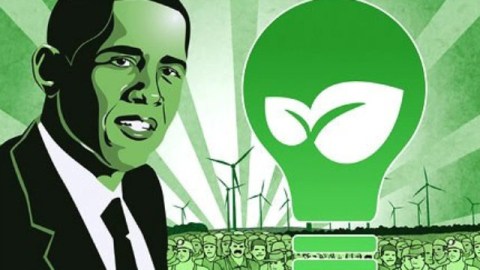A Message Without Resonance? Green Jobs Creation Slowed By Cheap Price of Dirty Energy

Last week the Washington Postran a revealing front page article on the challenges facing the Obama’s administration’s efforts to create a market for renewable energy products and so-called “green” jobs. The Administration has bet heavily on both the economic and political prospects in this area, devoting nearly 1/8 of the stimulus bill or $90 billion to green energy incentives and job training programs. The problem, as the WPost notes, is that the price of traditional “dirty” energy sources remains too cheap to mobilize market shifts, despite the stimulus spending.
The green jobs emphasis has been an important focus of candidate and President Obama, an effort to frame energy policy in terms of economic growth. The focus was also the dominant frame of reference in memorable–and what I judged very effective— commercial ads by Al Gore’s Repower America campaign that ran through last year.
But without tangible, localized evidence of these market changes, for many members of the public, the resonance of the frame as applied to energy policy is likely to weaken. The Washington Post article is one of several news reports to question progress on the front. Look for more news attention to emerge as the economy continues to struggle.
Here’s the key excerpts from the Post article:
With nearly 15 million Americans out of work and the unemployment rate hovering above 9 percent for 18 consecutive months, policymakers desperate to stoke job creation have bet heavily on green energy. The Obama administration channeled more than $90 billion from the $814 billion economic stimulus bill into clean energy technology, confident that the investment would grow into the economy’s next big thing.
The infusion of money is going to projects such as weatherizing public buildings and constructing advanced battery plants in the industrial Midwest, financing solar electric plants in the Mojave desert and training green energy workers.
But the huge federal investment has run headlong into the stubborn reality that the market for renewable energy products – and workers – remains in its infancy. The administration says that its stimulus investment has saved or created 225,000 jobs in the green energy industry, a pittance in an economy that has shed 7.5 million jobs since the recession took hold in December 2007.
The industry’s growth has been undercut by the simple economic fact that fossil fuels remain cheaper than renewables. Both Obama administration officials and green energy executives say that the business needs not just government incentives, but also rules and regulations that force people and business to turn to renewable energy.
Without government mandates dictating how much renewable energy utilities must use to generate electricity, or placing a price on the polluting carbon emitted by fossil fuels, they say, green energy cannot begin to reach its job creation potential.
“We keep getting these stops and starts in the industry. There is no way it can work like this,” said Bill Gallagher, president of Solar-Fit, a Florida energy company whose fortunes have fluctuated with government incentives in its 35 years in business.
Like many people who run renewable energy companies, Gallagher said he sees no need to expand his 25-employee firm because the business is simply not there….
….
Although 29 states have enacted laws setting benchmarks for the amount of energy utilities must generate from renewable sources such as wind and solar, the standards vary greatly. And with a new congressional majority poised to take office – including many members elected pledging to reduce Washington’s role in the economy – it remains an open question whether new federal regulations that would support expansion of the industry would be enacted anytime soon.
“Green energy investment has been a central talking point of the Obama administration’s job growth strategy,” said Samuel Sherraden, a policy analyst at the New America Foundation, a nonpartisan research organization. “It was a little bit too ambitious given the size and depth of the recession and the small size of the renewable energy industry.”
Sherraden said it was unwise for the administration to invest so heavily in green energy, at least if short-term job creation was the goal. He said green energy comes with “political and market uncertainty” that has overwhelmed its job creation potential….
…other administration officials acknowledge that it is likely to be years before the spending on green energy produces large numbers of jobs. And they add that only part of the money earmarked for green energy has been spent. They also agree that the government will have to help create demand to support green energy.
Still, they are optimistic for the long term, even if the spending will not significantly ease the nation’s unemployment crisis in the short run.
The money going into building car battery plants, for example, could allow the nation to capture as much as 40 percent of the global demand in that growing business in five to seven years, said Carol M. Browner, director of the White House Office of Energy and Climate Change Policy.
“This stuff is coming on line,” Browner said. “We all want it to come on line much more quickly.”
See also:
Nisbet, M.C. (2009). Communicating Climate Change: Why Frames Matter to Public Engagement. Environment, 51 (2), 514-518. (HTML).





